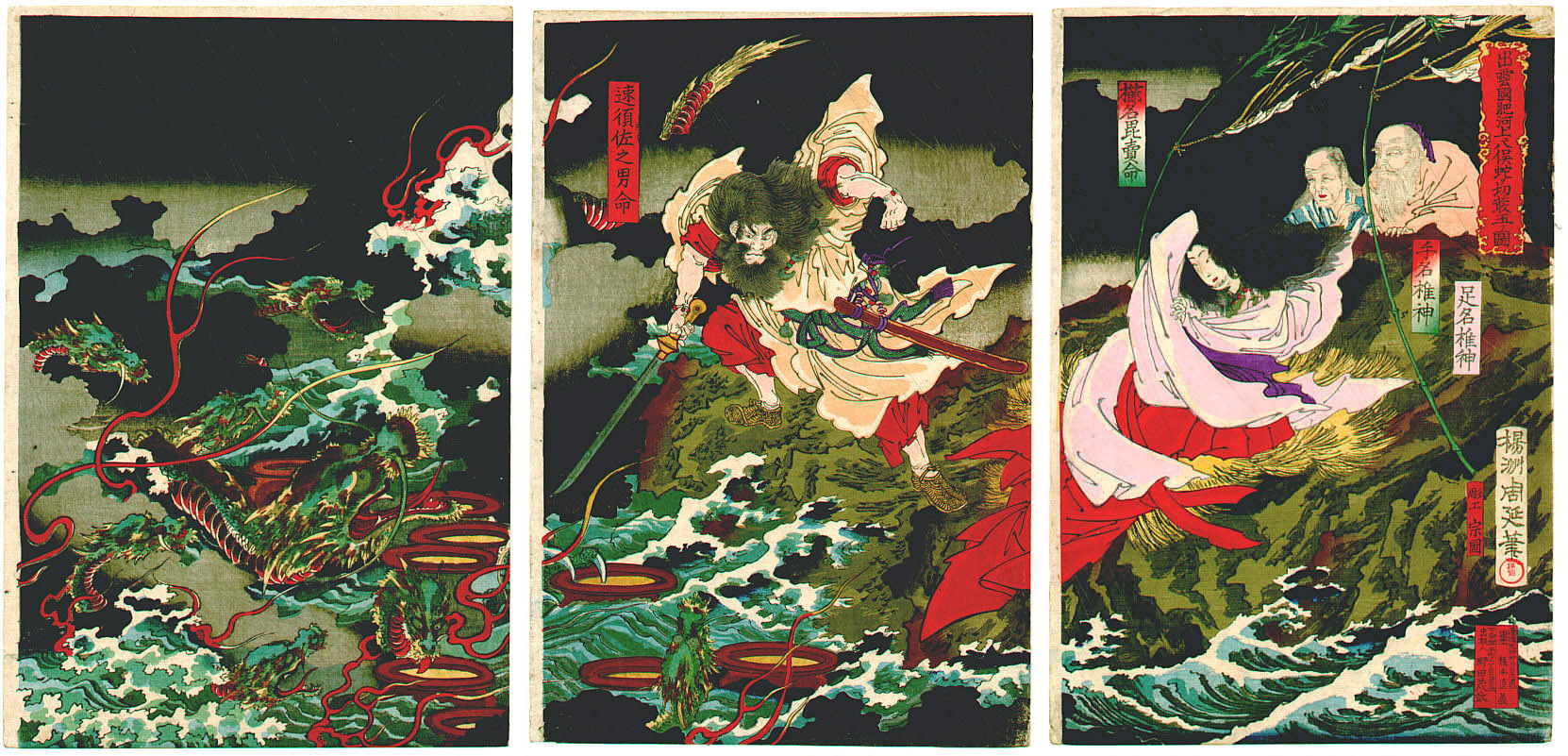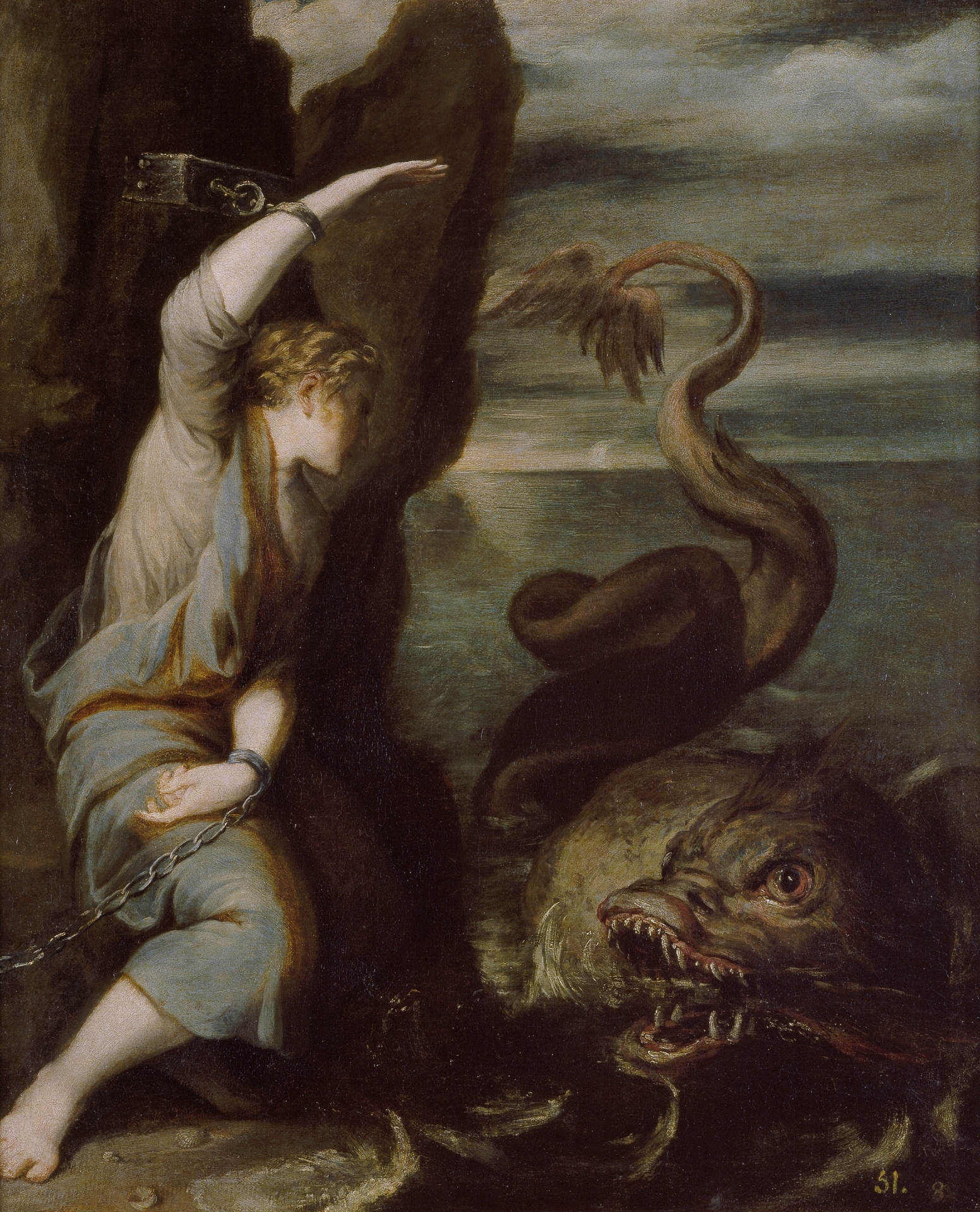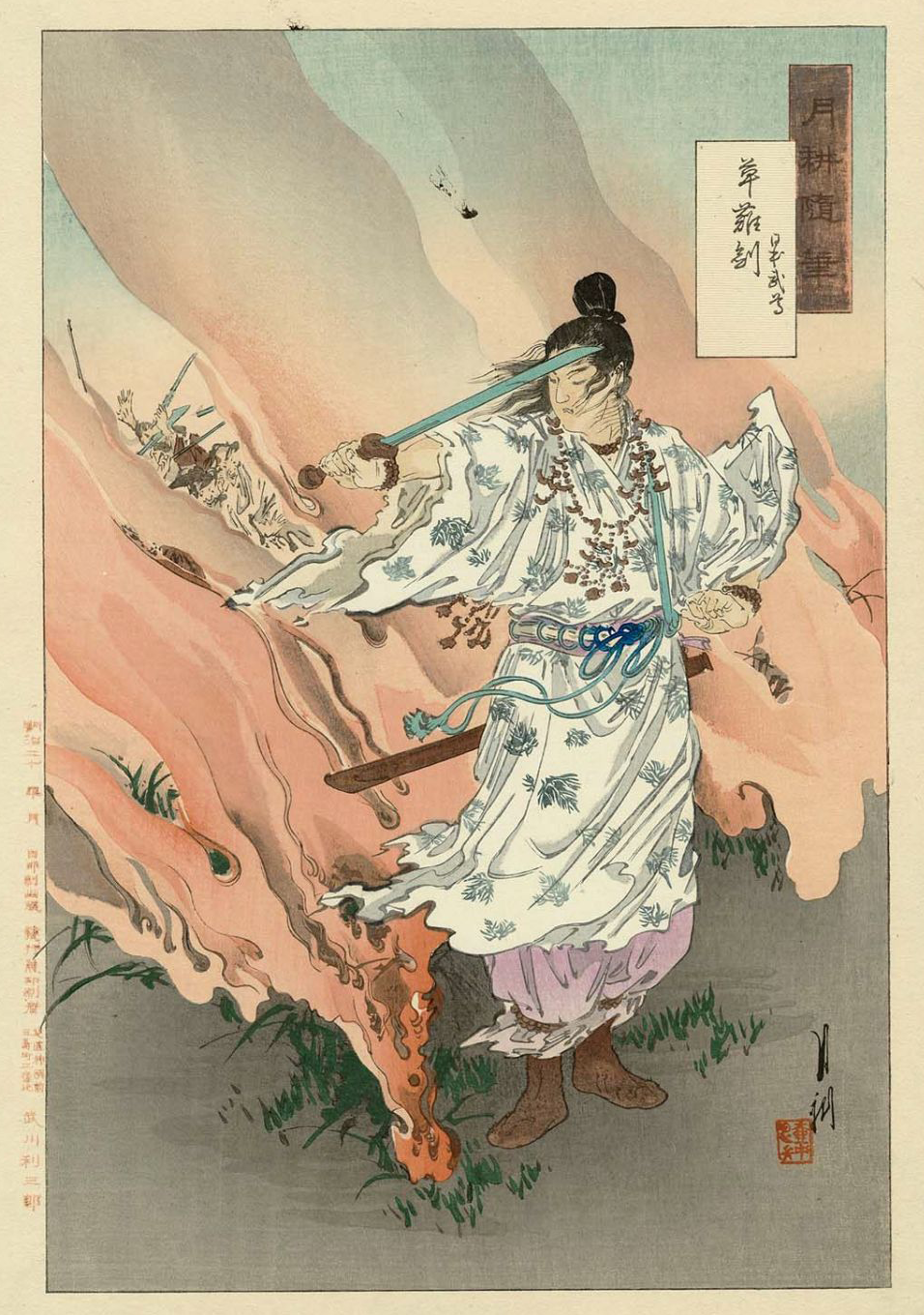|
Yamata-no-Orochi
, or simply , is a legendary eight-headed and eight-tailed Japanese dragon/serpent. Mythology Yamata no Orochi legends are originally recorded in two ancient texts about Japanese mythology and history. The 712 AD transcribes this dragon name as and the 720 AD writes it as . In both versions of the Orochi myth, the Shinto storm god Susanoo (or "Susa-no-O") is expelled from Heaven for tricking his sister Amaterasu, the sun goddess. After expulsion from Heaven, Susanoo encounters two near the head of the , now called the , in Izumo Province. They are weeping because they were forced to give the Orochi one of their daughters every year for seven years, and now they must sacrifice their eighth, , who Susanoo transforms into a for safekeeping. The tells the following version: The also describes Yamata no Orochi: "It had an eight-forked head and an eight-forked tail; its eyes were red, like the winter-cherry; and on its back firs and cypresses were growing. As it crawled i ... [...More Info...] [...Related Items...] OR: [Wikipedia] [Google] [Baidu] |
Susanoo
__FORCETOC__ Susanoo (; historical orthography: , ) is a in Japanese mythology. The younger brother of Amaterasu, goddess of the sun and mythical ancestress of the Japanese imperial line, he is a multifaceted deity with contradictory characteristics (both good and bad), being portrayed in various stories either as a wild, impetuous god associated with the sea and storms, as a heroic figure who killed a monstrous serpent, or as a local deity linked with the harvest and agriculture. Syncretic beliefs that arose after the introduction of Buddhism to Japan also saw Susanoo becoming conflated with deities of pestilence and disease. Susanoo, alongside Amaterasu and the earthly Ōkuninushi (also Ōnamuchi) – depicted as either Susanoo's son or scion depending on the source – is one of the central deities of the imperial Japanese mythological cycle recorded in the ( CE) and the (720 CE). One of the gazetteer reports () commissioned by the imperial court during the same per ... [...More Info...] [...Related Items...] OR: [Wikipedia] [Google] [Baidu] |
Kushinadahime
, also known as or Inadahime among other names, is a goddess (''kami'') in Japanese mythology. She is one of the wives of the god Susanoo, who rescued her from the monster Yamata no Orochi. Name The goddess is named 'Kushinadahime' (櫛名田比売) in the ''Kojiki'', while the '' Nihon Shoki'' variously names her 'Kushiinadahime' (奇稲田姫), 'Inadahime' (稲田姫), and 'Makamifuru-Kushiinadahime' (真髪触奇稲田媛). 'Inadahime' may be translated either as "lady / princess ('' hime'') of Inada", with "Inada" (稲田) here being understood as the name of a place in Izumo Province (part of what is now the town of Okuizumo (formerly Yokota) in Nita District, Shimane Prefecture), or "lady / princess of the rice fields" (''inada'' literally translated means "rice field" or "rice paddy"). The element ''kushi'' (Old Japanese: ''kusi'') meanwhile is usually interpreted as the adjective meaning "wondrous"; it is homophonous with the word for "comb" (櫛), which features in ... [...More Info...] [...Related Items...] OR: [Wikipedia] [Google] [Baidu] |
Princess And Dragon
Princess and dragon is a archetypical premise common to many legends, fairy tales, and chivalric romances. Northrop Frye identified it as a central form of the quest romance. The story involves an upper-class woman, generally a princess or similar high-ranking nobility, saved from a dragon, either a literal dragon or a similar danger, by the virtuous hero (see Damsel in distress). She may be the first woman endangered by the peril, or may be the end of a long succession of women who were not of as high birth as she is, nor as fortunate. Normally the princess ends up married to the dragon-slayer. The motifs of the hero who finds the princess about to be sacrificed to the dragon and saves her, the false hero who takes his place, and the final revelation of the true hero, are the identifying marks of the Aarne–Thompson folktale type 300, the Dragon-Slayer. They also appear in type 303, the Two Brothers. These two tales have been found, in different variants, in countries all ... [...More Info...] [...Related Items...] OR: [Wikipedia] [Google] [Baidu] |
Kojiki
The , also sometimes read as or , is an early Japanese chronicle of myths, legends, hymns, genealogies, oral traditions, and semi-historical accounts down to 641 concerning the origin of the Japanese archipelago, the , and the Japanese imperial line. It is claimed in its preface to have been composed by Ō no Yasumaro at the request of Empress Genmei in the early 8th century (711–712), and thus is usually considered to be the oldest extant literary work in Japan. The myths contained in the as well as the are part of the inspiration behind many practices. Later, they were incorporated into Shinto practices such as the purification ritual. Composition It is believed that the compilation of various genealogical and anecdotal histories of the imperial (Yamato) court and prominent clans began during the reigns of Emperors Keitai and Kinmei in the 6th century, with the first concerted effort at historical compilation of which we have record being the one made in 620 under ... [...More Info...] [...Related Items...] OR: [Wikipedia] [Google] [Baidu] |
Kusanagi
is a legendary Japanese sword and one of three Imperial Regalia of Japan. It was originally called , but its name was later changed to the more popular ("Grass-Cutting Sword"). In folklore, the sword represents the virtue of valor. Legends The history of the extends into legend. According to , the god Susanoo encountered a grieving family of ("gods of the land") headed by in Izumo Province. When Susanoo inquired of Ashinazuchi, he told him that his family was being terrorized by the fearsome Yamata no Orochi, an eight-headed serpent of Koshi, who had consumed seven of the family's eight daughters and that the creature was coming for his final daughter, . Susanoo investigated the creature, and after an abortive encounter he returned with a plan to defeat it. In return, he asked for Kushinada-hime's hand in marriage, which was agreed. Transforming her temporarily into a comb (one interpreter reads this section as "using a comb he turns into asquerades asKushinada-hime") to ... [...More Info...] [...Related Items...] OR: [Wikipedia] [Google] [Baidu] |
Magatama
are curved, comma-shaped beads that appeared in prehistoric Japan from the Final Jōmon period through the Kofun period, approximately 1000 BCE to the 6th century CE. The beads, also described as "jewels", were made of primitive stone and earthen materials in the early period, but by the end of the Kofun period were made almost exclusively of jade. originally served as decorative jewelry, but by the end of the Kofun period functioned as ceremonial and religious objects. Archaeological evidence suggests that were produced in specific areas of Japan and were widely dispersed throughout the Japanese archipelago to the Southern Koreanic kingdoms via trade routes. Jōmon period first appeared in Japan in the Final Jōmon period (1000–300 BCE), and in this period were made from relatively simple, naturally occurring materials, including clay, talc, slate, quartz, gneiss, jadeite, nephrite, and serpentinite. from the Jōmon period were irregularly shaped, lacked continuity in f ... [...More Info...] [...Related Items...] OR: [Wikipedia] [Google] [Baidu] |
Cryptomeria
''Cryptomeria'' (literally "hidden parts") is a monotypic genus of conifer in the cypress family Cupressaceae, formerly belonging to the family Taxodiaceae. It includes only one species, ''Cryptomeria japonica'' ( syn. ''Cupressus japonica'' L.f.). It used to be considered by some to be endemic to Japan (see remark below under 'Endemism'), where it is known as . The tree is called Japanese cedar or Japanese redwood in English. It has been extensively introduced and cultivated for wood production on the Azores. Description ''Cryptomeria'' is a very large evergreen tree, reaching up to tall and trunk diameter, with red-brown bark which peels in vertical strips. The leaves are arranged spirally, needle-like, long; and the seed cones globular, diameter with about 20–40 scales. It is superficially similar to the related giant sequoia (''Sequoiadendron giganteum''), from which it can be differentiated by the longer leaves (under in the giant sequoia) and smaller cones ( in ... [...More Info...] [...Related Items...] OR: [Wikipedia] [Google] [Baidu] |
Yata No Kagami
is a sacred bronze mirror that is part of the Imperial Regalia of Japan. Name and significance The represents "wisdom" or "honesty," depending on the source. Its name literally means "The Eight wikt:咫#Japanese, Mirror," a reference to its size. Mirrors in ancient Japan represented truth because they merely reflected what was shown, and were objects of mystique and reverence (being uncommon items). According to Shinsuke Takenaka at the Institute of Moralogy, is considered the most precious of the three sacred treasures. History In the year 1040 ( 1, 9th month), the compartment which contained the Sacred Mirror was burned in a fire. Whether that mirror was irrevocably lost or not, it is said to be housed today in Ise Grand Shrine, in Mie Prefecture, Japan, although a lack of public access makes this difficult to verify. Presently, a replica is enshrined in Three Palace Sanctuaries of the Tokyo Imperial Palace, Imperial Palace in Tokyo. Mythology In Shinto, the mirror ... [...More Info...] [...Related Items...] OR: [Wikipedia] [Google] [Baidu] |
Imperial Regalia Of Japan
The are the imperial regalia of Japan and consist of the sword , the mirror , and the jewel . They represent the three primary virtues: valour (the sword), wisdom (the mirror), and benevolence (the jewel).ミニ講話 宮司のいい話 (in Japanese). The actual historical status of these legendary treasures is unknown as they are intentionally kept from public view to symbolize authority. Legend  According to legend, these treasures were brought to Earth by
According to legend, these treasures were brought to Earth by [...More Info...] [...Related Items...] OR: [Wikipedia] [Google] [Baidu] |
Lycopodiopsida
Lycopodiopsida is a class of vascular plants known as lycopods, lycophytes or other terms including the component lyco-. Members of the class are also called clubmosses, firmosses, spikemosses and quillworts. They have dichotomously branching stems bearing simple leaves called microphylls and reproduce by means of spores borne in sporangia on the sides of the stems at the bases of the leaves. Although living species are small, during the Carboniferous, extinct tree-like forms formed huge forests that dominated the landscape and contributed to coal deposits. The nomenclature and classification of plants with microphylls varies substantially among authors. A consensus classification for extant (living) species was produced in 2016 by the Pteridophyte Phylogeny Group (PPG I), which places them all in the class Lycopodiopsida, which includes the classes Isoetopsida and Selaginellopsida used in other systems. (See Table 2.) Alternative classification systems have used ranks fro ... [...More Info...] [...Related Items...] OR: [Wikipedia] [Google] [Baidu] |
Japanese Language
is spoken natively by about 128 million people, primarily by Japanese people and primarily in Japan, the only country where it is the national language. Japanese belongs to the Japonic or Japanese- Ryukyuan language family. There have been many attempts to group the Japonic languages with other families such as the Ainu, Austroasiatic, Koreanic, and the now-discredited Altaic, but none of these proposals has gained widespread acceptance. Little is known of the language's prehistory, or when it first appeared in Japan. Chinese documents from the 3rd century AD recorded a few Japanese words, but substantial Old Japanese texts did not appear until the 8th century. From the Heian period (794–1185), there was a massive influx of Sino-Japanese vocabulary into the language, affecting the phonology of Early Middle Japanese. Late Middle Japanese (1185–1600) saw extensive grammatical changes and the first appearance of European loanwords. The basis of the standard dialect moved f ... [...More Info...] [...Related Items...] OR: [Wikipedia] [Google] [Baidu] |




.png)




